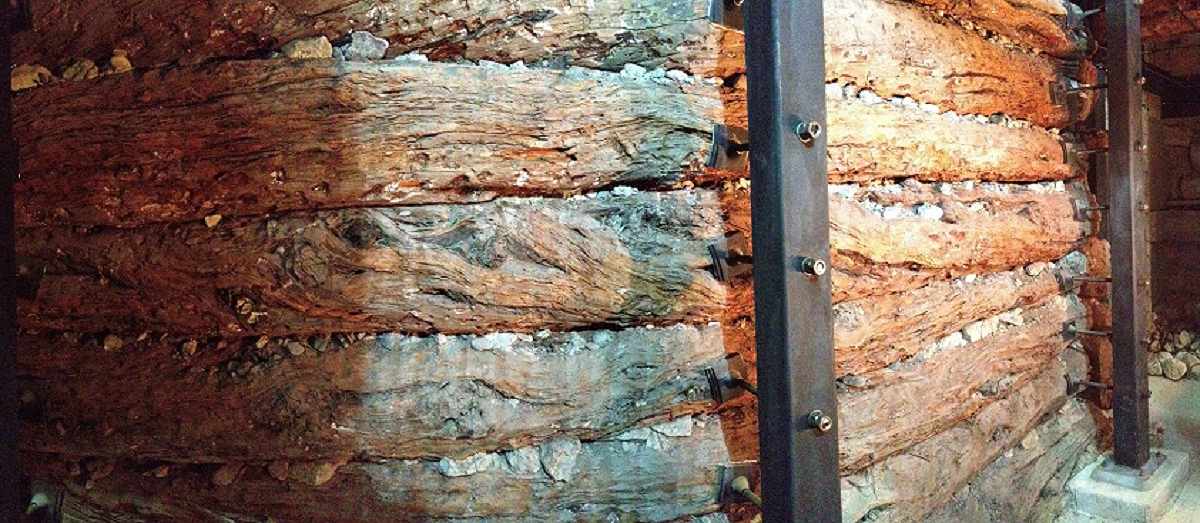
Part of a wooden burial structure constructed around 748 B.C. and built from juniper trees that grew during the time of the ancient Hittite empire is seen inside a mound at the site of the ancient city of Gordion in Turkey in this undated handout image.
13:26 JST, March 8, 2023
WASHINGTON (Reuters) — Around 1200 B.C., human civilization experienced a harrowing setback with the near-simultaneous demise or diminishment of several important empires in the Middle East and eastern Mediterranean region — an event called the Bronze Age collapse.
One of the mightiest to perish was the Hittite empire, centered in modern Turkey and spanning parts of Syria and Iraq. Last month, researchers offered new insight into the Hittite collapse, with an examination of trees alive at the time showing three consecutive years of severe drought that may have caused crop failures, famine and political-societal disintegration.
The Hittites, with their capital Hattusa situated in central Anatolia, were one of the ancient world’s great powers across five centuries. They became the main geopolitical rivals of ancient Egypt during its glittering New Kingdom period.
“In pre-modern times, with none of our infrastructure and technology, the Hittites controlled and ruled a huge region for centuries despite myriad challenges of space, threats from neighbors and entities incorporated into their empire, and despite being centered in a semi-arid region,” said Cornell University professor of arts and sciences in classics Sturt Manning, lead author of the research published in the journal Nature.
Scholars long have pondered what triggered the fall of the Hittites and broader collapse that also devastated kingdoms in Greece, Crete and the Middle East while weakening the Egyptians. Hypotheses have included war, invasion and climate change. The new study offers some clarity about the Hittites.
The researchers examined long-lived juniper trees that grew in the region at the time and eventually were harvested to build a wooden structure southwest of Ankara around 748 B.C. that may have been the burial chamber for a relative of Phrygia’s King Midas, whose legend holds he turned anything he touched into gold.
The trees offered a regional paleoclimatic record in two ways: patterns of annual tree-ring growth, with narrow rings indicating dry conditions; and the ratio of two forms, or isotopes, of carbon in the rings, revealing the tree’s response to water availability.
They detected a gradual shift to drier conditions from the 13th century B.C. into the 12th century B.C. More importantly, both lines of evidence indicated three straight years of severe drought, in 1198 B.C., 1197 B.C. and 1196 B.C., coinciding with the known timing of the empire’s dissolution.
“There was likely near-complete crop failure for three consecutive years. The people most likely had food stores that would get them through a single year of drought. But when hit with three consecutive years, there was no food to sustain them,” University of Georgia anthropology professor and study coauthor Brita Lorentzen said.
“This would have led to a collapse of the tax base, mass desertion of the large Hittite military and likely a mass movement of people seeking survival. The Hittites were also challenged by not having a port or other easy avenues to move food into the area,” Lorentzen added.
"Science & Nature" POPULAR ARTICLE
-

Genome Study Reveals Milestone in History of Cat Domestication
-

Big Leap in Quest to Get to Bottom of Climate Ice Mystery
-

Japan Set to Participate in EU’s R&D Framework, Aims to Boost Cooperation in Tech, Energy
-

Paws on Parade: Nairobi’s Dogs Dazzle at ‘Pawchella’
-

Japan’s H3 Rocket Failed in Latest Launch, Says Official
JN ACCESS RANKING
-

Tokyo Economic Security Forum to Hold Inaugural Meeting Amid Tense Global Environment
-

Keidanren Chairman Yoshinobu Tsutsui Visits Kashiwazaki-Kariwa Nuclear Power Plant; Inspects New Emergency Safety System
-

Imports of Rare Earths from China Facing Delays, May Be Caused by Deterioration of Japan-China Relations
-

University of Tokyo Professor Discusses Japanese Economic Security in Interview Ahead of Forum
-

Japan Pulls out of Vietnam Nuclear Project, Complicating Hanoi’s Power Plans






















